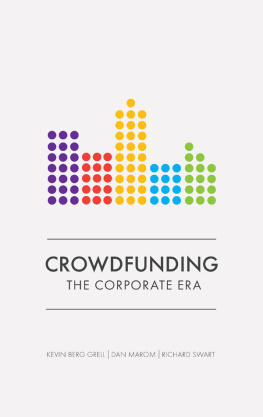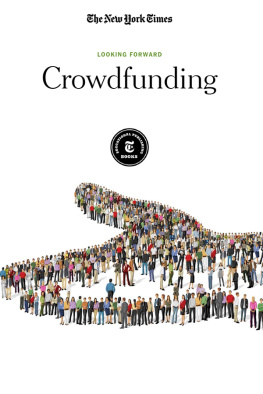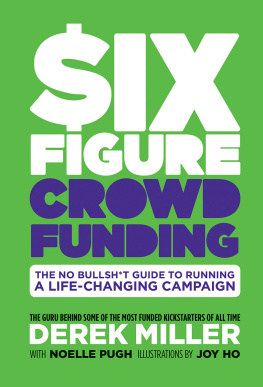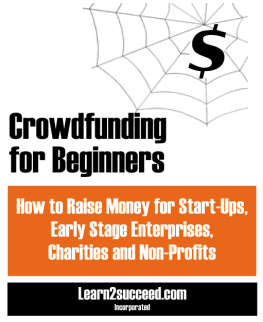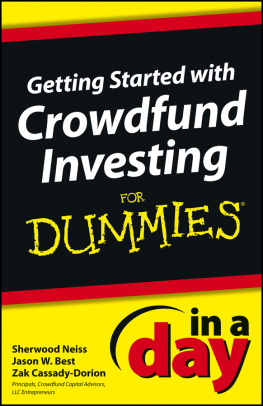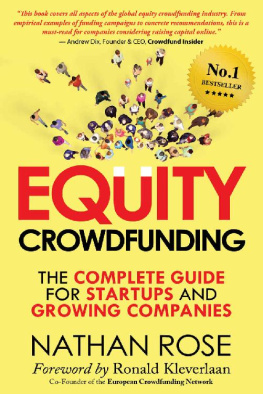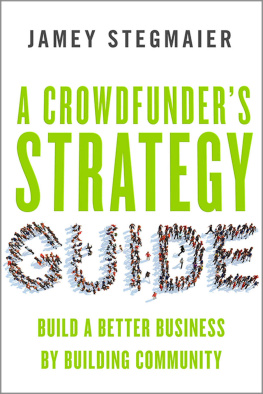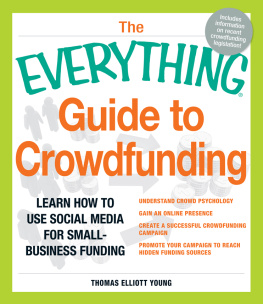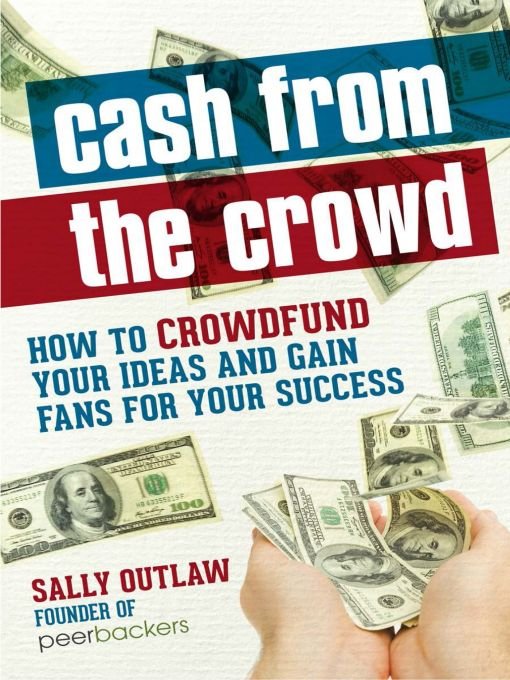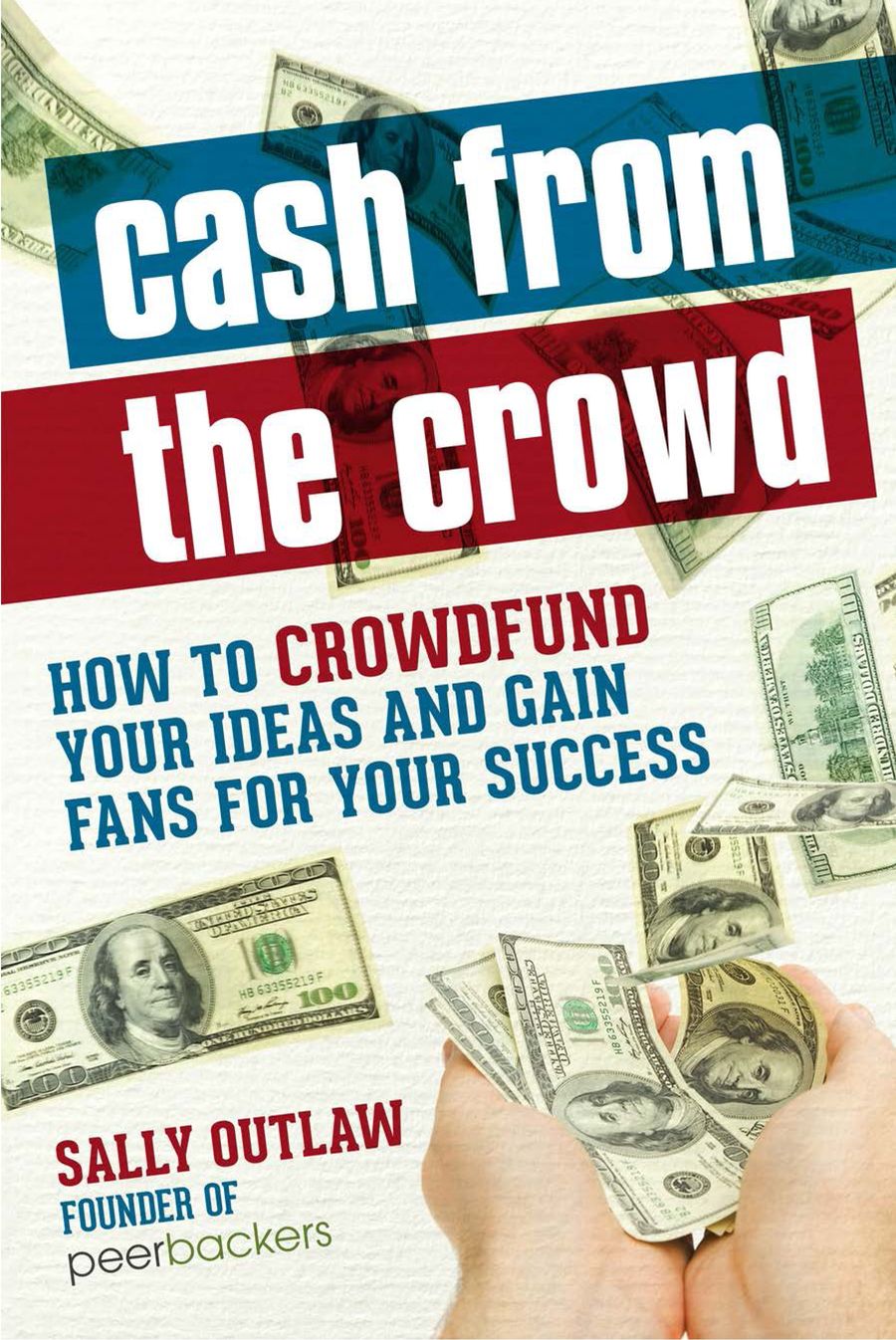Table of Contents
ACKNOWLEDGMENTS
Thanks first to all those who take financing their dreams into their own hands and crowdfund. You are helping to shape an industry, transform our country, and get our economy back on track.
I also offer much appreciation to those who took the time to speak with me about their campaigns and industry insights, as well as to my business partner Andrew Rachmell; my family Mark, Madison, and Brendan Outlaw, who endured my takeover of the dining room table while I wrote and Jeanine Lovely whose hours of interview transcription allowed me to focus on content creation.
It has also been a pleasure to work with Jillian McTigue, director of Entrepreneur Press, and Roe DAngelo, who I thank for her brilliant editing and continuous encouragement! Much appreciation also goes out to Karen Billipp of Eliot House Productions for her patience and skill in composing the book.
PREFACE
Im one of you. An entrepreneur who needs funds but who does not have the benefit of a robust Rolodex of angel investors, venture capitalists, or heck, even a plethora of wealthy friends on whom I can call. Over the years I have managed to launch and grow several companies, but each time the process of scraping together the funding was daunting. How do hardworking and dedicated entrepreneurs without connections raise capital? There had to be a better way.
So Im home one Friday night and I see a TV news piece about a man in England who was tired of only billionaires owning sports teams. He decided to fund a soccer team via the web by offering as many people as possible the chance to give just a little bit (about $50 each) to become owners of a team that they would recruit and manage. He raised $400,000 in the first 48 hours the opportunity went live on the internet. As I watched this story unfold, my first thought was, Why cant this approach be used for businesses? That night was the beginning of my efforts to launch a funding platform to support entrepreneurs, and the start of a now multiyear journey to shape an entirely new industry.
I bring to this book the unique perspective of serial entrepreneur, founder of a leading crowdfunding platform, and former crowdfunding campaign owner (yes, I crowdfunded, in part, the launch of my companys website). Perhaps most significantly, I have personally reviewed thousands of submissions to our crowdfunding website and have consulted with many of those who have been most successful on our platform. I know what it takes to run a successful campaign and I want to help every entrepreneur I can to reach their funding goal (to this end we also launched Crowdfunding Academy where we offer education, support, and even experts to give you custom feedback on your campaign).
It is exciting for me to see that with the rise of crowdfunding, entrepreneurs no longer have to confront the gatekeepers who control access to things like money and sales channels. We can now go directly to the crowd to share our message, pre-sell our products, and thanks to things like 3D printing, get access to the inexpensive tools we need to see our visions come to life.
INTRODUCTION
If, like me, you dont have an impressive list of investors at hand, this book is for you. Take heart in the fact that while you may not know one person who can write you a check for $5,000, I bet you know 100 people who, if you had a good idea, would each give you $50. Raising money this wayfrom many people in small incrementsis the essence of crowdfunding.
Crowdfunding, where individuals appeal for contributions from the public using an online platform, is becoming a powerful way to fund new entrepreneurial projects and ventures. Massolution, a research and advisory firm specializing in crowdsourcing, reported that in 2012 crowdfunding platforms grew 81 percent and raised $2.7 billion; they are forecasted to bring in over $5.1 billion in 2013. Although this has the potential to be a tremendous financial boon to entrepreneurs and innovators, on average 60 percent of all crowdfunding projects fail.
So what does it take to win the hearts and wallets of potential backers? By applying the advice and strategies in this book, you can properly prepare and communicate your project with passion, creativity, and the effectiveness required to fund your dream.
Along with a brief introduction to what crowdfunding is and for whom it works best, this book offers tips, best practices, and resources for creating and running a successful crowdfunding campaign. The advice covered is segmented into Pre-Campaign, Campaign Launch, and Post-Launch sections and includes insights from successful and unsuccessful project owners. The book closes with an overview of the new laws currently being shaped that will soon allow for equity crowdfunding investment and includes helpful checklists, as well as links to examples of effective campaign videos.
Even though this book focuses on entrepreneurial campaigns, the advice can be applied to any form of crowdfunding, whether for social causes, art and science efforts, educational endeavors, or any other ideas that need support.
As John Allston once said, The only thing you take with you when youre gone is what you leave behind, so... go build something!
chapter 1
CROWDFUNDING EXPLAINED
Reality Check: Having a good idea is not enoughyou
have to convince the crowd.
While the term crowdfunding is seemingly self-explanatoryfunding from a crowdit can also be misleading and might in part be to blame for why the majority of funding campaigns fail. For the most part, crowds are not roaming these funding platforms looking for random projects to support (but yes, you can attract strangers to your campaign by employing the tips and techniques covered in this book). For crowdfunding to work, you need a combination of elements, including a great idea, an engaged following, compelling thank-you perks, and several months that you can dedicate to your campaign.
Crowdfunding is where you raise money by asking the crowd to directly fund your idea or venture in small increments (e.g., $25 or $50 per person), and then pool this money to meet a funding goal. You post your idea on a crowdfunding website and use its built-in templates to create your presentation, including things like a funding goal and fundraising timeline, an explanatory video, and thank-you perks you offer as incentives to contribute, and use the provided social media tools to promote your posted project to the world. Success requires a strong community from which you can draw support, whether you are lucky enough to start with one or must build one before you begin your campaign. Project owners must take an active role in running what is truly a full-fledged fundraising campaign, including consistently promoting their project page via every channel imaginable. Think politicsdo you see those campaign ads just once?
History and Overview
Crowdfunding is not new; its been successfully used by politicians soliciting campaign donations and by social organizations raising money to meet the needs of victims of tragedies. Long before technologies and social media advanced, publisher Joseph Pulitzer used crowdfunding in 1885 to raise the $100,000 needed to complete payment of the pedestal of the Statue of Liberty. When efforts to raise $250,000 for the granite base fell short, Mr. Pulitzer used his newspaper,






